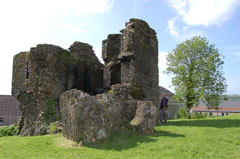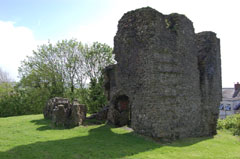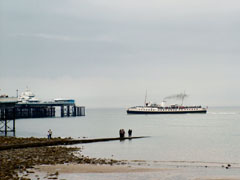Llandudno is a seaside resort and town in North Wales. It lies on the coast between Bangor and Colwyn Bay, and has a population of about 20,000. The town is just off the main rail line between Chester and Holyhead, the latter being the main ferry port for travel to Ireland. Llandudno was specifically built as a mid-Victorian era holiday destination and is served by a branch line from Llandudno Junction with stations at Deganwy and Llandudno.
Llandudno, Queen of the Welsh Resorts is now the largest seaside resort in Wales, and lies on a flat land between the Welsh mainland and the Great Orme peninsula. Llandudno takes its name from the ancient parish of Saint Tudno but also encompasses several neighbouring townships and districts including Craig-y-Don, Llanrhos, and Penrhyn Bay.
Llandudno Bay and the North Shore
This wide sweep of sand and shingle extends two miles in a graceful curve between the headlands of the Great Orme and the Little Orme. For most of the distance on Llandudno's North Shore there is a wide curving Victorian promenade separated from the roadway by a strip of garden. The road, collectively known as The Parade, has a different name for each block and it is on these parades and crescents that many of Llandudno's hotels are built. Near the centre of the bay is the North Wales Theatre and next to it The North Wales Conference Centre. The Llandudno Yacht Club and a roundabout mark the end of this section of the The Parade and beyond are more hotels and guest houses but they are in the township of Craig-y-Don. At Nant-y-Gamar road, The Parade becomes Colwyn Road with the fields of Bodafon Hall Farm on the landward side but with the promenade continuing until it ends in a large paddling pool for children and finally the Craigside residential development on the lower slopes of the Little Orme.
Llandudno Pier
The town's elegant pier is on the North Shore; it was built in 1878, and is 1,234 feet in length and a Grade II listed building. Looking back towards the town from the end of the pier, on a clear day one can see the mountains of Snowdonia rising over the town. A curious major extension of the pier in 1884 was in a landwards direction along the side of the Grand Hotel to provide a new entrance with a pier pavilion at the North Parade end of the promenade, thus increasing its length to 2,295 feet. In the summer, Professor Codman's Punch and Judy show can be found at the entrance to the promenade.
The Great Orme
This great limestone headland has many attractions for the tourist including the Great Orme Tramway that takes tourists effortlessly to the summit. Two features of the Great Orme should be mentioned here because the both start at the end of the promenade where North Parade becomes for a short distance Happy Valley Road, which in its turn becomes the Marine Drive.
The Happy Valley
The Happy Valley, a former quarry, was the gift of Lord Mostyn to the town in celebration of the Golden Jubilee of Queen Victoria in 1887. The area was landscaped and developed as gardens, two miniature golf courses, a putting green, a popular open air theatre and extensive lawns. The ceremonies connected with the Welsh National Eisteddfod were held there in 1896 and again in 1963. In June 1969, The Great Orme Cabin Lift, a modern alternative to the tramway, was opened with its base station adjacent to the open air theatre. The distance to the summit is just over one mile and the four-seater cabins travel at six m.p.h. on a continuous steel cable over two miles long. It is the longest single stage cabin lift in Britain and the longest span between pylons is over 1,000 feet. The popularity of open air theatre having declined, the theatre closed in the 1980's and likewise the two miniature golf courses closed and were converted in 1987 to create a 280 metre artificial ski slope and toboggan run. The gardens were extensively restored as part of the resort's millennium celebrations and remain a major attraction.
The Marine Drive
The first route round the perimeter of the Great Orme was a footpath constructed in 1858. In 1872 the Great Ormes Head Marine Drive Co. Ltd. was formed to turn the path into a carriage road. Following bankruptcy, a second company completed the road in 1878. The road was bought by Llandudno Urban District Council in 1897. The four mile drive (it is one way only) starts at the foot of the Happy Valley and is a pleasant drive or an excellent walk. After about one and a half miles, a side road leads to St. Tudno's Church, the Great Orme Bronze Age Copper Mine, and the Summit of the Great Orme. But, continuing on the Marine Drive one passes the Great Orme Lighthouse (no longer operational) and at the half way point the 'Rest and be thankful' Caf� is very popular with both walkers and motorists. This is almost the highest point on the drive and it is down hill for two miles to the West Shore.
The West Shore
The West Shore is the quiet beach on the estuary of the River Conwy. It was here at Pen Morfa that Alice Liddell (of Alice in Wonderland fame) spent the long summer holidays of her childhood from 1862 to 1871. There are few hotels and a few quiet residential streets. The West Shore is linked to the North Shore by Gloddaeth Avenue, a wide dual carriageway.
Mostyn Street
Running behind the promenade is Mostyn Street (often known locally as the high street) leading to Mostyn Broadway and then Mostyn Avenue. These are the main shopping streets of Llandudno and Craig-y-Don. Mostyn Street accommodates the high street shops, the major banks and building societies, two churches, amusement arcades and the town public library. The latter is the starting point for the Town Trail a carefully planned walk to facilitate the viewing of Llandudno in an historical perspective.
Llandudno Victorian Extravaganza
Every year in May Bank Holiday weekend, Llandudno has a great three-day Victorian Carnival and Mostyn Street becomes a fairground. Madoc Street and Gloddaeth Street and the Promenade become part of the route each day of a mid-day carnival parade. The Bodafon Farm fields become the location of a Festival of Transport for the weekend.
Llandudno Lifeboat
Llandudno is unique within the UK in that its lifeboat station is located inland, allowing it to launch with equal facility from either the West Shore or the North Shore as needed. Llandudno's active volunteer crews are called out more than ever with the rapidly increasing numbers of small pleasure craft sailing in coastal waters. The Llandudno Lifeboat is normally on display on the promenade on Summer Sunday mornings.
Churches
The ancient parish church dedicated to Saint Tudno stands in a hollow near the northern point of the Great Orme and two miles from the present town. It was established as an oratory by Tudno, a sixth century monk, but the present church dates from the 12th century and it is still used on summer Sunday mornings. It was the Anglican parish church of Llandudno until that status was transferred first to St George�s (now closed) and later to Holy Trinity Church in Mostyn Street.
The principal Christian Churches of Llandudno include the Church in Wales (Holy Trinity and also Saint Paul's at Craig-y-Don), the Roman Catholic Church of Our Lady Star of the Sea, Saint John�s Methodist Church, Gloddaeth United Church (Presbyterian), Assemblies of God (Pentecostal), Llandudno Baptist Church, St. David's Methodist Church at Craig-y-Don, the Coptic Orthodox Church and Eglwys Unedig Gymraeg Llandudno (the United Welsh Church). These churches all have fine buildings.
A high profile member of the local Methodist community is Rev. Roger Roberts, now Baron Roberts of Llandudno, Liberal Democrat Spokesman for International Development in the House of Lords.
Cultural connections
Llandudno hosted the Welsh National Eisteddfod in 1864, 1896 and 1963.
Matthew Arnold gives a vivid and lengthy description of 1860s Llandudno � and of the ancient tales of Taliesin and Maelgwn that are associated with the local landscape � in the first sections of the preface to On the Study of Celtic Literature (1867).
Llandudno claims a passing link with Lewis Carroll; because the family of the "real Alice" regularly spent holidays at their holiday-home Penmorfa, now the Penmorfa Hotel on the wild West Shore of Llandudno. Contrary to local myth, Alice Liddell did not meet Carroll in the town, and was not told the Alice stories in the town. It is, however, just possible that she may have first read the Alice books in print while on holiday in the town. There is no evidence that Carroll ever visited Penmorfa, and he probably would have been unwelcome if he had. Indeed, there is contrary evidence; a letter exists, written by one of Alice Liddell's sisters when grown-up, saying she had no memory of Carroll ever visiting the girls in Llandudno.
Queen Elisabeth of Roumania, the writer Carmen Sylva, stayed in Llandudno for five weeks in 1890 and on taking her leave described Wales as "a beautiful haven of peace". Translated into Welsh as "hardd, hafan, hedd" it became the town's official motto.
Other famous people with links to Llandudno include the Victorian Statesman John Bright and multi-capped Welsh international footballers Neville Southall and Joey Jones. Australian ex-PM the late Billy Hughes attended school in Llandudno.
Llandudno is twinned with the Flemish town of Wormhout ten miles from Dunkerque. It was there that many members of the Llandudno-based 69th Territorial Regiment were ambushed and taken prisoner. Later, at nearby Esquelbecq on 28 May 1940, the prisoners were shot.
Currently, the town is home to the international art gallery, Oriel Mostyn, The North Wales Theatre and The North Wales Conference Centre.
For further information see: http://www.llandudno.gov.uk/
 Trains: Llandudno is on the Conwy Valley Line Trains: Llandudno is on the Conwy Valley Line
 Libraries: Libraries:
 Llandudno Library Llandudno Library
Mostyn Street
Llandudno
LL30 2RP
01492 574010/574020
Mon 9.00am-6.00pm
Tue 9.00am-6.00pm
Wed 10.00am-5.00pm
Thur 9.00am-7.00pm
Fri 9.00am-6.00pm
Sat 9.30am-1.00pm
 Rugby: Llandudno RFC Rugby: Llandudno RFC
 Football: Llandudno FC Football: Llandudno FC
 Theatre: Venue Cymru Theatre: Venue Cymru |













Lauriston Court Hotel has a website by the way: http://www.lauristoncourt.com/
All the best
Paul